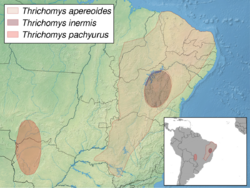Biology:Punaré
From HandWiki
| Punaré | |
|---|---|
| Scientific classification | |
| Domain: | Eukaryota |
| Kingdom: | Animalia |
| Phylum: | Chordata |
| Class: | Mammalia |
| Order: | Rodentia |
| Family: | Echimyidae |
| Subfamily: | Echimyinae |
| Tribe: | Myocastorini |
| Genus: | Thrichomys Trouessart, 1880 |
| Type species | |
| Nelomys apereoides Lund, 1839
| |
| Species | |
|
Thrichomys apereoides | |

| |
The punaré are all found in the genus Thrichomys. They are South American rodents in the family Echimyidae.[1] It contains at least five species, found in Bolivia, Brazil and Paraguay.[2][3] They are as follows:
- Common punaré (Thrichomys apereoides)
- Highlands punaré (Thrichomys inermis)
- Paraguayan punaré (Thrichomys pachyurus)
- Thrichomys laurentius
- Thrichomys fosteri
Phylogeny
The genus Thrichomys shares evolutionary affinities with two pairs of Myocastorini genera: Callistomys (the painted tree-rat) and Myocastor (the coypu or nutria) on the one hand, and Hoplomys (the armored rat) and Proechimys on the other hand.
| Genus-level cladogram of the Myocastorini |
References
- ↑ Woods, C.A.; Kilpatrick, C.W. (2005). "Infraorder Hystricognathi". in Wilson, D.E.; Reeder, D.M. Mammal Species of the World: A Taxonomic and Geographic Reference (3rd ed.). Johns Hopkins University Press. pp. 1589. ISBN 978-0-8018-8221-0. OCLC 62265494. http://www.departments.bucknell.edu/biology/resources/msw3/browse.asp?id=13400519.
- ↑ E., Braggio,; R., Bonvicino, C. (2004-04-12). "Molecular Divergence in the Genus Thrichomys (Rodentia, Echimyidae)" (in en). Journal of Mammalogy 85 (2). doi:10.1644/1545-1542(2004)085<0316:mditgt>2.0.co;2. ISSN 0022-2372. https://doi.org/10.1644/1545-1542(2004)085%3C0316:MDITGT%3E2.0.CO;2.
- ↑ Nascimento, Fabrícia F.; Lazar, Ana; Menezes, Albert N.; Durans, Andressa da Matta; Moreira, Jânio C.; Salazar-Bravo, Jorge; D′Andrea, Paulo S.; Bonvicino, Cibele R. (2013-04-18). "The Role of Historical Barriers in the Diversification Processes in Open Vegetation Formations during the Miocene/Pliocene Using an Ancient Rodent Lineage as a Model". PLOS ONE 8 (4): e61924. doi:10.1371/journal.pone.0061924. ISSN 1932-6203. http://journals.plos.org/plosone/article?id=10.1371/journal.pone.0061924.
Wikidata ☰ Q846023 entry

